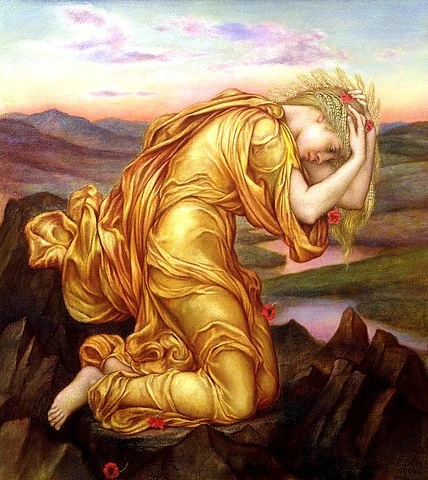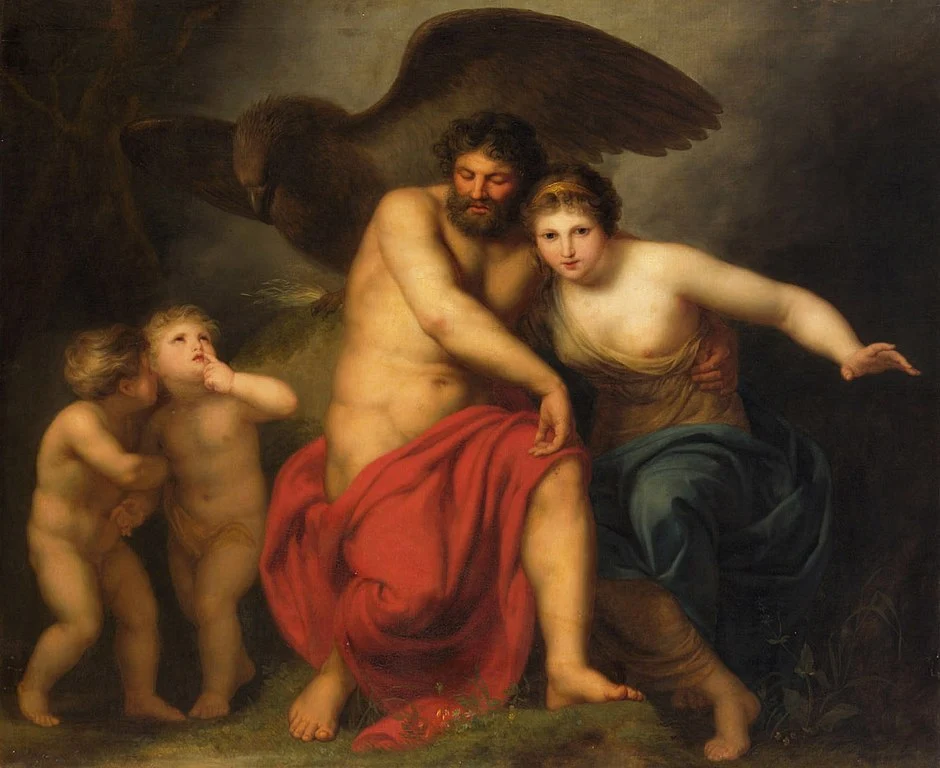Greek mythology is renowned for its heroic exploits, divine battles, and cultural influence. Yet, it also contains scandalous narratives of infidelity, clandestine affairs, and unconventional parentage. Zeus, the king of the gods, stands as a prominent figure in these tales. Despite his marriage to several goddesses and titanesses, with his sibling Hera being his last wife, Zeus’ amorous escapades with other women feature prominently in Greek mythology.
How Many Wives Did Zeus Have?
Zeus had seven wives in Greek mythology. His spouses included Metis, Themis, Eurynome, Demeter, Mnemosyne, Leto, and Hera. These unions led to the birth of various divine offspring, including the Horae, Moirai, Charites, Persephone, Ares, Athena, the Muses, and gods like Apollo and Artemis.
The Seven Wives of Zeus were:
Metis – The First Wife of Zeus
Metis, the remarkable Oceanid was the first wife of Zeus. As the daughter of Oceanus and Tethys, she personified wisdom, deep thought, and prudence. Her union with Zeus, which began after the fall of the Titans, was marked by her invaluable assistance in helping Zeus rescue his siblings whom Cronus had devoured. Metis’ wisdom and guidance were instrumental in the rise of the Olympian gods.
However, their marital bliss was short-lived, A prophecy warned that Metis’ second child would dethrone Zeus, mirroring his own actions against Cronus. Disturbed by this revelation and seeking to maintain his rule, Zeus resorted to a cunning ploy. He tricked Metis into transforming into a fly and swallowed her, unknowingly ingesting the wisdom she held.
Unbeknownst to Zeus, Metis was already pregnant with their child, Athena. Inside Zeus’s body, she began crafting intricate armor for her daughter. This unforeseen pregnancy caused Zeus excruciating headaches, prompting him to seek relief. He summoned Hephaestus, who, with an axe, opened Zeus’s head. Athena emerged from Zeus’s head, fully grown and wearing armor.
Themis – The Titan Aunt Zeus Married
Themis, an eminent Titan goddess and the second wife of Zeus, held a profound significance in Greek mythology. As the daughter of Uranus and Gaea, she personified the essence of natural and moral order, embodying the divine laws governing not only gods but also the entire cosmos.
Themis played a crucial role in Zeus’s ascension to power, acting as his trusted advisor. Following the victory of the Olympians over the Titans, Themis contributed significantly to stabilizing Zeus’s rule on Mount Olympus, helping him establish his authority over both gods and mortals.
Themis and Zeus’s union bore fruit in the form of six children, each of whom personified essential aspects of the world’s order and destiny. The first trio, known as the Horae or Hours, represented the seasons and the cyclical passage of time. Eunomia, symbolizing order, Dike, embodying justice, and Eirene, the goddess of peace, together maintained the natural and moral harmony of the world.
The other three children, the Moirai or Fates, were the weavers of destiny. Clotho, the spinner, Lachesis, the allotter, and Atropos, the inevitable, determined the course of every individual’s life, from its inception to its ultimate conclusion.
Eurynome – The Third Bride of Zeus
Eurynome, a Titan goddess was the third wife of Zeus. She was born to the Titans Oceanus and Tethys, making her an Oceanid. Often depicted as a beautiful mermaid or an elder ocean nymph, Eurynome’s mythological role is marked by grace and nurturing.
In an early tale, Eurynome played a crucial role in the life of Hephaestus, the god of blacksmiths. When Hera cast Hephaestus out of Mount Olympus due to his physical deformity, Eurynome and Thetis caught him and provided care. They raised him as their own child, forging a deep connection between Eurynome and the Olympian gods.
As Zeus’s wife, Eurynome became the mother of the Charites, also known as the Charities. These goddesses personified qualities of beauty, grace, and goodwill. The three Charites were Aglaea, Euphrosyne, and Thalia. Aglaea, one of Eurynome’s daughters, went on to marry Hephaestus, linking the two families in divine matrimony.
Demeter – Sister/Wife of Zeus

Demeter, one of the revered Twelve Olympians, held a pivotal role in Greek mythology as the goddess of agriculture, grain, and Mother Earth herself. Born to Cronus and Rhea, she was both sister and wife to Zeus, a complex aspect of the divine family dynamics.
Zeus, in his pursuit of Demeter, was not consensual in many accounts. It’s said that he approached her in the guise of a bull, and from their union, Persephone, also known as Kore, was born. The story of Demeter revolves around her deep connection with her daughter.
The abduction of Persephone by Hades, who took her as his wife to the Underworld, plunged Demeter into profound grief. During her mourning, the earth suffered as crops withered and died, resulting in widespread famine.
Zeus intervened and brokered a deal with Hades, allowing Persephone to spend a portion of the year with her mother. This arrangement gave rise to the seasons, as during Persephone’s absence, Demeter’s sorrow plunged the world into winter, only to see it rejuvenated with her daughter’s return, symbolizing the cycle of death and rebirth.
Mnemosyne – The Mother of Nine Muses
Mnemosyne was the Titan goddess of time, memory, and remembrance. Born of Uranus and Gaia, she was not only renowned for her divine lineage but also for her pivotal role in inspiring the arts and literature.
Zeus, in a mortal shepherd’s guise, courted Mnemosyne for nine consecutive days, resulting in the conception of nine remarkable children: the Nine Muses. These Muses encompassed a wide spectrum of inspiration, each guiding and nurturing various domains of human creativity.
Urania, inspired by the heavens, became the Muse of Astronomy. Calliope, the Muse of epic poetry, chronicled heroic tales. Clio, the embodiment of history, guided the recording of past events. Melpomene, associated with tragedy, invoked powerful emotions in her artists. Terpsichore, the Muse of Dance, embodied rhythmic grace. Euterpe, devoted to flutes and music, stirred melodies. Erato, the Muse of lyric poetry, ignited the passions of love and beauty. Finally, Polyhymnia, the Muse of sacred poetry, guided the spiritual and divine aspects of human expression.
Mnemosyne’s influence, in conjunction with the Muses, served as the wellspring of inspiration for kings and poets alike, bestowing upon them extraordinary abilities in the realm of speech, art, and creativity.
Leto – The Lycian Wife of Zeus

Leto’s tale is a testament to the wrath of Hera and the endurance of a mother’s love. As one of the Titanides, daughters of Uranus and Gaia, Leto symbolized motherhood and the protection of the young. She was a popular goddess in the Lycian region of Anatolia.
Zeus, captivated by Leto’s beauty, courted her, leading to her pregnancy with his child. Hera, upon learning of this, unleashed her fury. She not only forbade Leto from giving birth on any land or island but relentlessly pursued her, leaving Leto without refuge.
Leto’s arduous journey in search of a safe haven ended on the island of Delos, where she found sanctuary. In some renditions, Poseidon played a role by raising the island from the seafloor, allowing Leto to give birth there on a technicality.
Despite the adversities she faced, Leto successfully brought forth her twin children, Apollo and Artemis, into the world. This tale reflects the indomitable spirit of motherhood and the lengths to which a mother would go to protect her offspring.
Hera – The Final Wife of Zeus

Hera, Zeus’s most renowned spouse and the Queen of the Gods plays a key role in several Greek Myths. She is not only Zeus’s wife but also his sister, being born to Cronus and Rhea. Their union began with Zeus’s clever ruse, transforming into an injured bird to invoke Hera’s compassion. Her nurturing nature compelled her to care for the bird, unaware of its true identity. Later, when Zeus revealed his divine form, he sought her hand in marriage. Their union endured for an impressive 300 years.
Hera was more than just Zeus’s wife; she was an Olympian goddess of profound importance. She symbolized women, family, marriage, and childbirth, making her a vital figure in ancient Greek life. Despite Zeus’s numerous infidelities throughout their marriage, Hera remained his principal spouse.
Together, Hera and Zeus had ten children, including Ares, the god of war, Hephaestus, the divine blacksmith, and Hebe, the goddess of youth. However, Hera’s character is often defined by her infamous jealousy, which leads her to torment Zeus’s lovers and illegitimate children. Her complex personality, balancing maternal care with vengeful wrath, is a recurring theme in her mythological stories.
